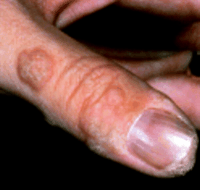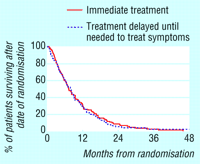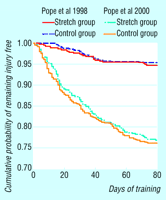This week in the BMJ
Volume 325, Number 7362, Issue of 31 Aug 2002Evidence for warts treatments is limited
Palliative thoracic radiotherapy can be delayed
Stretching does not reduce muscle soreness
How best to treat acne
Patients' characteristics determine consultation length
Physician assistants in the United States
How best to fund the NHS
Evidence for warts treatments is limited
Topical salicylic acid is an effective and safe treatment for warts,
but there is no clear evidence that any other treatments, including
cryotherapy, have a particular advantage of either higher cure rates or
fewer side effects. Gibbs and colleagues (p 461) conducted a systematic
review of local treatments and say that only 12 of 50 trials were of
high quality. Photodynamic therapy and pulsed dye lasers may, the
authors say, hold promise for the future.

(Credit: ST BART'S HOSPITAL/SPL)
Palliative thoracic radiotherapy can be delayed
Giving immediate palliative thoracic radiotherapy for patients with
locally advanced non-small cell lung cancer with minimal symptoms does
not improve symptom control, quality of life, or survival. In a
randomised controlled trial of 230 patients, Falk and colleagues (p
465) compared immediate radiotherapy with radiotherapy delayed until
needed to treat symptoms in patients with advanced disease but with few
thoracic symptoms. At six months' follow up, the groups did not differ
in terms of survival, presence of symptoms, activity level,
psychological distress, or survival.

Stretching does not reduce muscle soreness
Stretching before or after exercise does not protect against muscle
soreness. A systematic review by Herbert and Gabriel (p 468) shows that
stretching produces only small and non-significant reductions in muscle
soreness. Data from two studies on army recruits in military training
shows that muscle stretching before exercise does not usefully reduce
the risk of injury. The authors say, however, that the generality of
this finding needs further testing.

How best to treat acne
Acne vulgaris is a common condition that affects many adolescents
and adults at some time. On page 475 Webster gives an overview of
the pathogenesis, assessment, and treatment options for the condition.
Most effective acne regimens, he says, treat inflammatory and comedonal
acne lesions with a combination of antibacterial and retinoid
drugs. Poyner and Cunliffe (p 478) write an accompanying commentary that gives a UK primary care perspective on treating the
condition.

Patients' characteristics determine consultation length
Characteristics of patients have as much effect on consultation length
as the characteristics of doctors and doctors' country of practice
combined. Deveugele and colleagues (p 472) compared the results of
videotaped consultations in six European countries with known
determinants of consultation length. Consultation length varied from
country to country and was influenced by patients' sex and age and the
number of problems discussed. Women with psychosocial problems
consulting general practitioners in urban practices had longer
consultations than other patients.

Physician assistants in the United States
Since the 1960s the United States has developed the profession of
physician assistant, based on a concept dating back to the 17th
century, to work in primary care to relieve nationwide shortages of
doctors. More than 44 000 physician assistants now work in America.
They mainly work semi-autonomously in association with individual
doctors, but an increasing number work in hospitals. Mittman and
colleagues (p 485) outline their training, and functions; they say
that physician assistants could provide Britain with a viable
alternative to physicians in areas where shortages of doctors
exist.

How best to fund the NHS
With rising costs of the healthcare system in England, how should the
NHS be funded? On page 488 Green and Irvine argue for a system based on
social insurance, as in France and Germany. McKee and colleagues say
that the current tax based system recognises that those whose needs are
greatest are least able to pay for care, and the young and rich
subsidise the old and poor. A shift to competing insurance funds, they
say, will relieve the rich of this burden but is this the real
issue?
but is this the real
issue?

(Credit: REX)